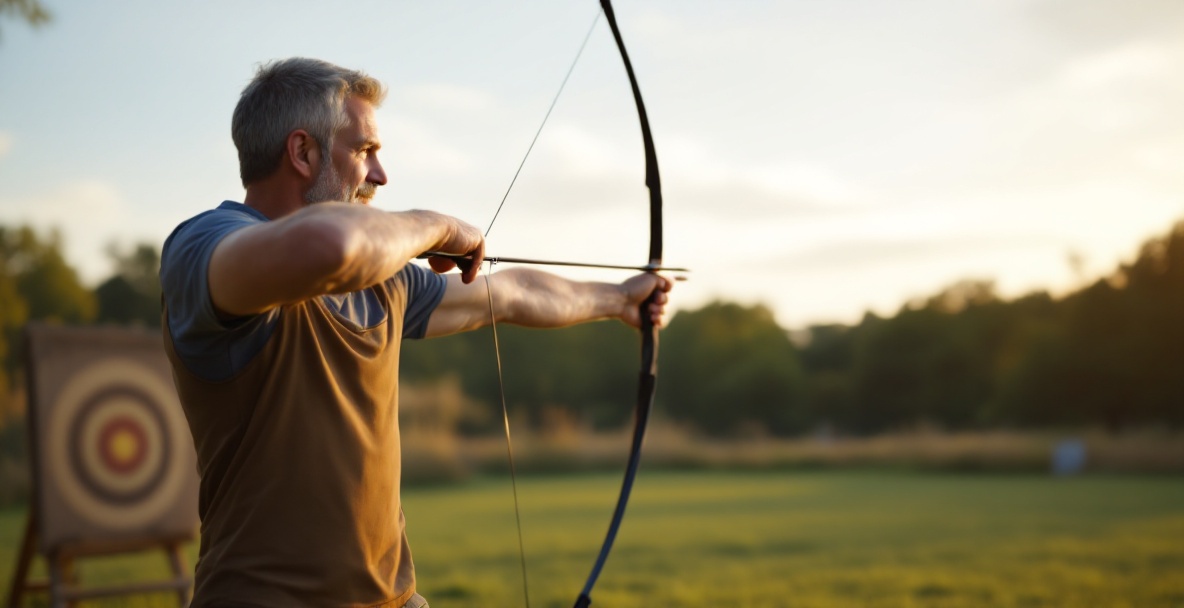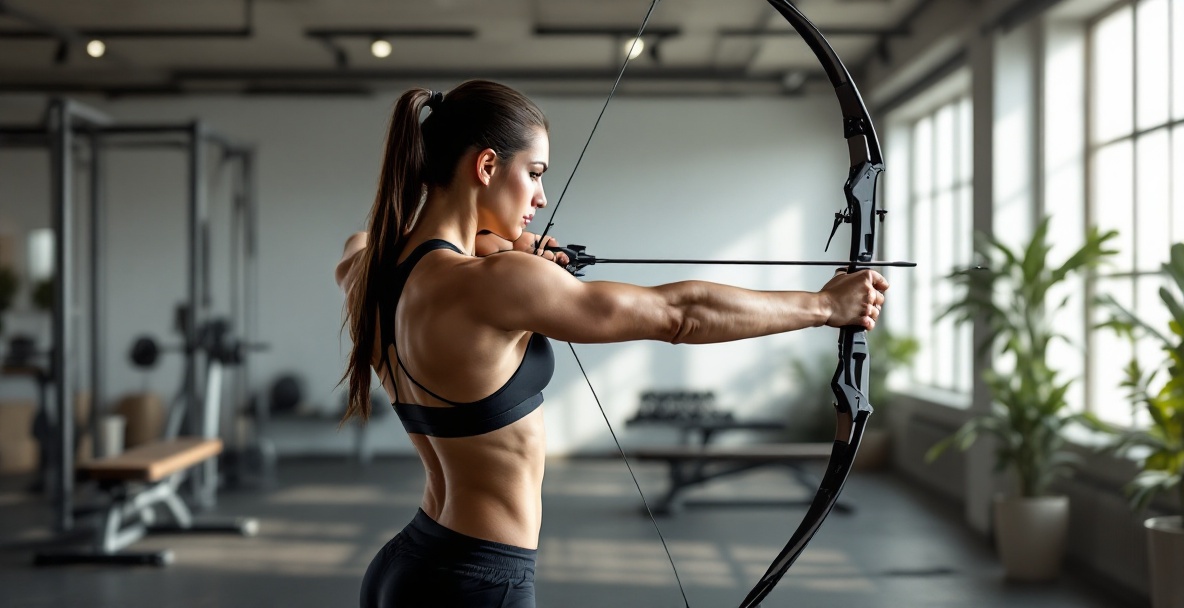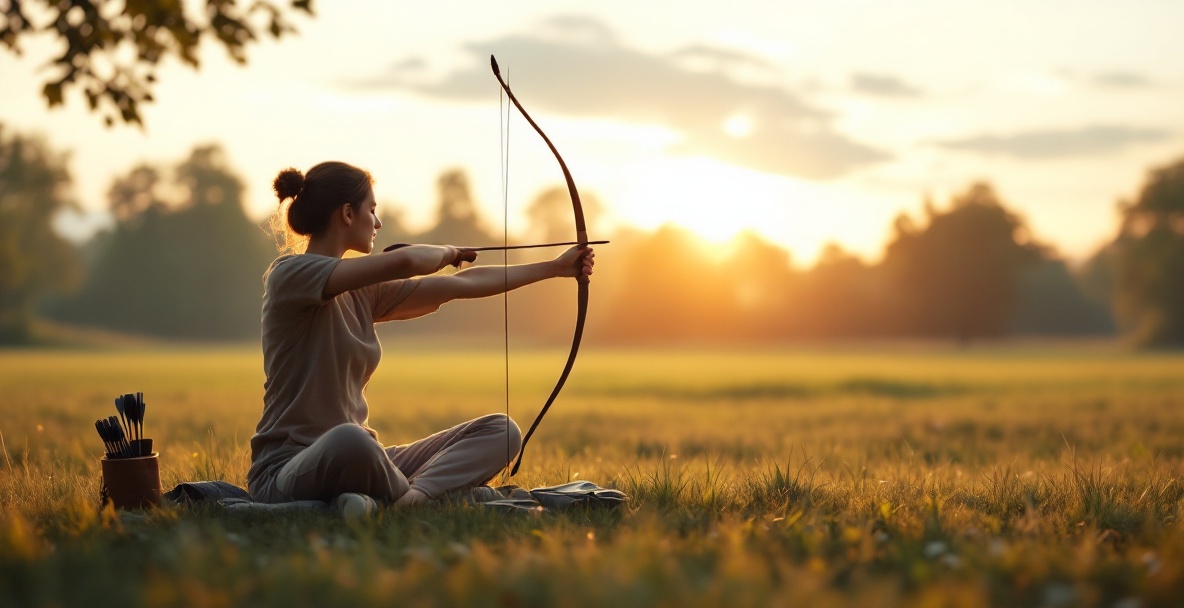Nailing Your Perfect Draw: Why Building Strong Muscles Matters

Hitting that perfect draw is not just about technique-it all comes down to your muscle strength and endurance. Many archers spend hours on aim and release but often miss the importance of honing the exact muscles that power the draw. Building these muscles not only lets you handle heavier bows but also boosts your stability, consistency, and stamina on the range. Whether you are training with our precision-engineered stabilizer weights or simply practicing solo, knowing and strengthening your draw muscles is the secret to real archery success.
The Muscles That Power Your Draw
When you pull back a bow, many muscles team up in a finely tuned effort. You may think your arms carry most of the load, but your back muscles are the real champions. Your rhomboids and trapezius pull your shoulder blades together to start the movement, and your latissimus dorsi (lats) adds the extra push needed to finish the draw. These muscle groups work together like a well-oiled engine, giving you the force required for smooth, steady shots.
Your powerful back muscles drive every smooth and consistent draw.
| Muscle Group | Primary Role in Draw Cycle | Example Exercise | Equipment Needed |
|---|---|---|---|
| Rhomboids & Middle Traps | Scapular retraction and initial pull | Resistance-band rows | Light to medium band |
| Latissimus Dorsi (Lats) | Power through full draw | Single-arm cable pulldown | Cable machine or band |
| Rotator Cuff | Shoulder joint stabilization | External rotation with band | Mini band |
| Deltoids | Bow-arm elevation and hold | Overhead dumbbell press | Dumbbells |
| Core (Abs & Erector Spinae) | Postural support and energy transfer | Plank variations | Body-weight |
Your rotator cuff muscles work hard to keep your shoulder in the right place as you draw. Without solid strength here, you risk shoulder instability or injury during extended practice sessions or competitions. Your shoulder muscles, especially the deltoids, help lift and steady your bow while your biceps and forearms manage string tension to keep your grip firm.
Your core, including your abs and lower back, forms the bridge between your upper and lower body. A strong core limits unnecessary movement and helps maintain a steady posture throughout your shot sequence. When all these muscles work in harmony, your draw becomes smoother, more consistent, and gentler on your body; much like how our stackable stabilizer weights balance mass across your bow.
Real Challenges Archers Face
Fatigue is one of the biggest hurdles when practicing or competing. As your muscles tire, your form starts to slip, and each shot can feel off. Many archers notice a drop in performance after only 30 to 60 minutes, with arrows beginning to spread out on the target. This tiredness not only skews your accuracy but also paves the way for bad habits that may affect your technique in the long run.
Muscle fatigue is one of the most common obstacles in your archery practice and competitions.
| Typical Issue | Physical Trigger | Common Symptom on Target Face | Priority Exercise Focus |
|---|---|---|---|
| Muscle fatigue | Insufficient back and shoulder endurance | Group widens after 30–60 min | High-rep resistance-band rows |
| Target panic | Strain while holding at full draw | Rushed or anxious releases | Isometric planks and breathing drills |
| Inconsistent draw length | Weak muscle memory under fatigue | Vertical spread of arrows | Draw-length drill with light bow and metronome |
The pressure during a shot can even lead to target panic or rushed releases when your muscles aren’t up to the task. When drawing becomes physically demanding, you might hurry your shot or develop a flinch just to ease discomfort. Often, these issues come from weak muscle conditioning rather than a mental block. The remedy is simple-build up that specific muscle strength by building specific muscle strength so holding a full draw feels natural and steady.
Some archers also struggle to maintain the same draw length each time. This problem is common with compound bows that lack hard stops or with traditional bows, where muscle memory is key. Without enough strength and endurance, it becomes hard to keep the draw consistent, even if the change is just a few millimeters. Strong muscles give you reliable performance throughout your session. With a focused exercise routine, you can turn frustrating inconsistency into dependable precision.
Warm-Up: Get Your Body Ready for Action

Before jumping into hard exercises to power your draw, a proper warm-up is a must. Taking a little extra time to get moving can help you avoid injuries and improve your performance during practice or competition. Your muscles need a gentle start, especially if you are using extra gear like our stabilizer weights. A smart warm-up boosts blood flow, warms up your muscles, and readies your body for the precise actions of archery.
Dynamic Stretches to Kick Things Off
Dynamic stretches involve moving your body through its full range while gradually reaching further and quicker. Unlike holding a single stretch, these movements prepare your muscles for the active work ahead and can really help improve your overall shooting form.
Dynamic stretching means you move your body through its full range, gradually extending your reach and speeding up.
| Stretch Method | Movement Style | Ideal Timing | Key Archery Benefit |
|---|---|---|---|
| Dynamic | Active, rhythmic motions | Pre-shooting warm-up | Primes neuromuscular patterns and boosts blood flow |
| Static | Held end-range positions | Post-shooting cool-down | Enhances flexibility and aids recovery |
| Ballistic | Bouncing, explosive stretches | Rarely recommended | High injury risk outweighs benefits |
Start with arm circles by extending your arms out at your sides and making small circles that widen gradually over about 30 seconds in each direction. This simple activity warms up your shoulder joints, which are vital for a smooth draw. Next, stand with your feet apart and gently twist your upper body from one side to the other to engage your core and back muscles. Another effective move is shoulder blade squeezes. Stand straight with relaxed arms and pull your shoulder blades together as if gripping a pencil; hold for 2 to 3 seconds and then let go, repeating 10 to 15 times. These actions ready the muscles that will later manage the extra weight from your archery gear and boost your draw technique while reducing strain.
Breathe Easy and Stay Focused
Learning to control your breathing is not just important at the moment of release; it should be a natural part of your warm-up too. Steady, deep breaths help calm your heart and set a good rhythm for each shot. Practice diaphragmatic breathing by placing one hand on your chest and the other on your stomach. Breathe in deeply so your belly expands while your chest stays relatively still. This technique calms your nerves and sharpens focus; try inhaling for 4 seconds and exhaling for 6 seconds for about two minutes.
It also helps to take a moment to visualize your ideal shot. Spend 60 seconds picturing a smooth, balanced draw and a satisfying release. This mind-body trick carries over into your shooting, keeping you consistent even when your gear changes. And remember, your equipment should support your skill. Our stackable weight systems are built to adjust to your needs from the warm-up all the way through your training session.
Core Work: Build a Rock-Solid Foundation
A strong draw starts deep in your core, not just in your arms. Archers with a steady core enjoy better balance and more consistent shots. Think of your core as the power center that sends energy smoothly through your body during each draw and release. Here are two key exercises to boost your core strength, improve your archery form, and help you hold perfect alignment even during long sessions.
Plank Exercises and Variations
The plank may look basic, but it is one of the best ways to build the steady strength you need for archery. Begin by lying face down and placing your forearms on the floor with your elbows directly under your shoulders so that your body forms a straight line from head to heels. Tighten your core by pulling your belly button toward your spine and hold that position for 30 to 60 seconds, increasing the time gradually as you build strength.
Once you are comfortable with the basic plank, add variations that mirror your archery moves. The side plank is excellent for boosting balance, especially when holding a full draw. Lie on your side with your elbow right below your shoulder and keep your body straight. For an extra challenge, try the archer's plank by holding a standard plank while extending one arm forward as if drawing a bow. This variation targets the muscles that stabilize your bow arm.
If you use heavier gear with several stabilizer weights, consider the rolling plank. Start in a regular plank, then shift into a side plank, roll into a reverse plank, move to the opposite side plank, and return to the starting position. This series works your core in every direction and prepares you to maintain form under any conditions. Try for 2 to 3 sets, with 5 to 8 rotations per set.
Russian Twists for Extra Core Power
While planks build steady core strength, Russian twists add the rotational power needed for a consistent draw. Sit on the floor with your knees bent and feet flat (or slightly lifted) and lean back at about a 45-degree angle while keeping your back straight. Clasp your hands together or hold a light weight, and gently twist your torso from side to side, touching the floor beside your hips on each side.
The secret to effective Russian twists is to use your core-not just swinging your arms. Start the movement slowly from your middle and keep your shoulders relaxed. Try 2 to 3 sets of 10 to 15 twists. As you get stronger, you can add a bit of weight or lift your feet higher for more challenge.
For an archery-specific twist, hold a light resistance band with both hands in front of you as you rotate. This move mimics the tension you feel when drawing your bow and trains the stabilizing muscles that keep you balanced. Many archers using our heavier stainless steel weights notice improved control during long competitions. Strong core rotation means more reliable shots and less fatigue during extended practice.
Back and Shoulder Workouts: Boost Your Power and Control

Your back and shoulders are the workhorses of your draw. Building these muscles lays the groundwork for steady aim and lasting endurance during long sessions. When you strengthen these key areas, you not only reduce fatigue but also maintain a more consistent shooting form. These targeted workouts focus on the muscles that pull and hold your bow, leading to better performance on the range and more stability during critical shots.
Resistance Band Rows to Build Your Back Strength
Resistance band rows are a simple, effective way to train the muscles needed for a strong draw. Secure a resistance band at chest level on a stable object like a doorknob or pole. Stand with your feet shoulder-width apart, grab the band with your drawing hand, and start with a bit of tension already in place.
Pull the band toward you while focusing on squeezing your shoulder blade back, just as you do when drawing your bow. Keep your elbow at shoulder level so it doesn’t flare out. This move targets your rhomboids, middle trapezius, and latissimus dorsi-the powerhouse muscles behind your draw. Aim for 3 sets of 10 to 15 reps and gradually increase the resistance as you grow stronger.
Switch up your technique every now and then by trying high rows (pulling toward your chin) or low rows (pulling toward your waist). This variety challenges your back from different angles and helps keep your drawing form consistent throughout long sessions. Regular practice with resistance bands lets you handle heavier draw weights and makes the most of your precision weights.
Shoulder Presses to Build Endurance
Shoulder presses work directly on your deltoids, the muscles that keep your bow arm steady and your aim true. Using dumbbells or resistance bands, stand with your feet shoulder-width apart and keep your core tight. Start with the weights at shoulder level, palms facing forward, and press upward until your arms are nearly locked.
Lower the weights slowly, counting to three as you go to maximize muscle engagement. This controlled movement builds the endurance you need to hold your bow at full draw while keeping your arm rock steady. The extra stability from these presses pairs perfectly with the balance from quality stabilizer systems to limit any unwanted movements during your important shots.
If you want an extra challenge, move on to single-arm presses. This variation ups the demand on your core and better mimics the one-sided effort of drawing a bow. Aim for 3 sets of 8 to 12 reps, always focusing on form before picking up heavier weights. Recent research published in MDPI Sensors journal shows that solid shoulder stabilization can improve shot consistency and lower injury risk. As your endurance builds, holding full draw will feel more natural and consistent, leading to a smoother, more balanced shooting experience.
Cool Down: Unwind and Reflect

After a tough workout for your draw muscles, a good cool-down is just as important as the work you put in. Stretching and relaxing helps prevent muscle stiffness and gives you a moment to think about your progress. This final step helps keep your body balanced and ready for the next session.
Slow Stretches to Finish Up
Begin your cool-down with slow, gentle stretches that target the muscles you’ve just used. Hold each stretch for 30 to 45 seconds while taking deep, steady breaths. Start with a simple overhead reach: extend your draw arm toward the ceiling and then pull it gently across your body with your other hand to ease tension in your shoulders and upper back.
Next, try a doorway chest stretch to open up your pectorals. Stand in a doorway with your arm at a 90-degree angle against the frame, then slowly turn your body away until you feel a comfortable stretch. This movement helps counteract the tight position your muscles may hold during your draw, preventing imbalances that could affect your accuracy.
A study published in PubMed supports the idea that focused cool-down routines can cut muscle soreness and improve your range of motion for future sessions. Finish off with gentle wrist stretches: extend one arm with your palm up and use your other hand to pull your fingers back, then repeat with the palm facing down. These moves are vital, especially for archers practicing with stabilizers that add weight to their setup, as they help prevent repetitive strain injuries.
Take a Moment to Reflect on Your Progress
After training, set aside 5 to 10 quiet minutes to jot down your workout in a training journal. Write about which exercises you did, the resistance used, and any challenges or good feelings you experienced. This simple habit creates a clear record of your progress, shows patterns in your improvement, and highlights areas that need extra attention.
Notice how your draw feels after regular practice. Are you less fatigued? Can you hold longer? Many archers at OneX Archery find that tracking small wins provides a real boost, especially when they are customizing their equipment for comfort. Use this time to set goals for your next session. Recent research on sports psychology in archery shows that mindful reflection can lift your performance. Listen to your body, adjust your workouts if needed, and keep moving steadily toward your archery goals-all while enjoying the benefits of our durable archery tools.
Wrap-Up: Keep the Momentum Going
This guide has walked you through a complete routine to build the muscles that power a strong and steady draw. We covered everything from warming up and building core strength to boosting back and shoulder power and ending with a proper cool-down. Now you have a clear plan to develop the physical foundation needed for consistent archery. Remember, knowing these exercises is only the first step-it is the regular practice that will truly advance your skills.
Next Steps to Build Your Archery Strength
Consistency is the key to building muscle and refining your archery technique. Aim for 2 to 3 strength sessions each week and gradually up the intensity as you improve. Keep track of your progress with a journal or app, noting increases in your draw weight and endurance. This record will motivate you even when progress seems slow and help you identify which exercises work best for your body.
Consider organizing your training into focused cycles-one month for raw strength, the next for endurance, and another for flexibility and balance. This approach keeps your routine fresh and prevents plateaus. Remember, enhancing your overall archery accuracy relies not only on muscle strength but also on how you use that strength when shooting.
Your gear plays a big role too. As you build strength, you may need to customize your archery gear for maximum comfort. Our precision-engineered stabilizer weights from OneX Archery are designed to work with your training by balancing your bow perfectly, reducing fatigue and hand shock while boosting performance.
Join the Archery Community
Building stronger draw muscles is more fun when you share the journey. Join local clubs or online forums where you can swap tips, celebrate victories, and work through challenges with fellow archers. Many find that an accountability partner helps keep training on track-find someone with similar goals and check in each week.
Social media is a great place to share your milestones. Post videos of your progress, use relevant hashtags, or take part in monthly strength challenges. These interactions can spark new ideas and introduce you to training techniques you might not have discovered on your own. The shared wisdom of experienced archers can help you refine your routine and avoid common pitfalls.
Your feedback also helps shape better equipment. When archers share how stabilizer weights enhance their strength training, companies like OneX Archery can craft even better gear. The combination of solid physical training and durable, weather-resistant archery tools builds the steady edge you need for every shot.
Ready to transform your archery performance with stronger draw muscles and perfect balance? Implement these exercises consistently, and when you're ready to take your stability to the next level, explore our precision-engineered stabilizer weights at OneX Archery that will complement your newly developed strength and help you maintain perfect form shot after shot.
Leave a Reply